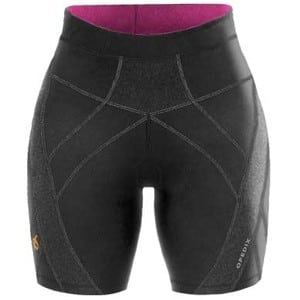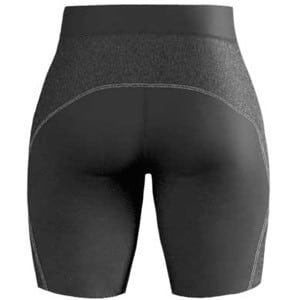For those of you who are longstanding readers of iRunFar’s gear reviews or who spend time with me on the trail, you know that I’ve been wearing compression garments for about the last three years. I know and love that, for me, compression wear in general provides a bit of biomechanical support, reduces the vibrations of soft tissues in the lower half of my body from impacting the ground, and reduces fluid retention after long runs and races, as well as during long travel outings. So, when the chance to test the Opedix CORE-Tec Short ($165) came my way, I didn’t hesitate. Three months later, I’m still totally stoked on this short.
Product Description
 I tested the women’s short in a size medium. This is a compression short that comes to about my belly button at the waist and mid-thigh on the leg, what appears to be about a 6.5-inch inseam for this size. According the the Opedix folks, the short’s composition is 90% nylon and 10% spandex. The waistline is two inches wide, composed of an inner, thick, elastic band covered on both sides with material. The waistline also has a shoelace-esque drawstring. The balance of the short is roughly half one layer of material, half an array of sewn-in panels on both the short’s front and back which add a second layer of material. When wearing the running shorts, the panels cover my low back/upper glutes, lower abdominals, and part of my quadriceps. The insides of the leg holes have a one-inch elastic band overlaid with silicone that are meant to prevent movement. There are no pockets; everything is attached with flatlock seams; and the crotch is gusseted. The available colors for women is black with a bright pink inner waistband and black with a medium blue inner waistband that you can’t see when the shorts are on. Finally, the shorts come in sizes extra small, small, medium, and large with a fitting chart comparing your US clothing size as well as your waist circumference to Opedix’s sizing.
I tested the women’s short in a size medium. This is a compression short that comes to about my belly button at the waist and mid-thigh on the leg, what appears to be about a 6.5-inch inseam for this size. According the the Opedix folks, the short’s composition is 90% nylon and 10% spandex. The waistline is two inches wide, composed of an inner, thick, elastic band covered on both sides with material. The waistline also has a shoelace-esque drawstring. The balance of the short is roughly half one layer of material, half an array of sewn-in panels on both the short’s front and back which add a second layer of material. When wearing the running shorts, the panels cover my low back/upper glutes, lower abdominals, and part of my quadriceps. The insides of the leg holes have a one-inch elastic band overlaid with silicone that are meant to prevent movement. There are no pockets; everything is attached with flatlock seams; and the crotch is gusseted. The available colors for women is black with a bright pink inner waistband and black with a medium blue inner waistband that you can’t see when the shorts are on. Finally, the shorts come in sizes extra small, small, medium, and large with a fitting chart comparing your US clothing size as well as your waist circumference to Opedix’s sizing.
What Opedix Claims the CORE-Tec Short Does
 It’s my understanding that Opedix began mostly within the ski industry, by a professional who had spent a lot of years skiing and was looking to save (what was left of) his and his friends’ knees and hips from the rigors of Alpine skiing. The company began with paneled tights that supposedly mimicked proper core and knee movement so as to support the body underneath and encourage it to behave properly. And, now, Opedix has expanded into the short which, obviously due to the lack of material around the knee, focuses on the core. Opedix’s market appears at present appears to be mostly Alpine skiers, snowboarders, and runners.
It’s my understanding that Opedix began mostly within the ski industry, by a professional who had spent a lot of years skiing and was looking to save (what was left of) his and his friends’ knees and hips from the rigors of Alpine skiing. The company began with paneled tights that supposedly mimicked proper core and knee movement so as to support the body underneath and encourage it to behave properly. And, now, Opedix has expanded into the short which, obviously due to the lack of material around the knee, focuses on the core. Opedix’s market appears at present appears to be mostly Alpine skiers, snowboarders, and runners.
When claiming that the Opedix CORE-Tec Short helps users maintain core stability, Opedix leans on a study recently done by researchers at the University of Denver’s Human Dynamics Laboratory on pelvic stability and proprioception. In the study, a very small number of subjects were asked to do a couple sitting and landing-based tasks both while wearing and not wearing the CORE-Tec short. The studies concluded that, while wearing the short, the subjects had significantly more stability and prioproception doing these (non-running and non-skiing/snowboarding-related) activities.
Fit and Performance
 I requested a women’s size medium because my waistline measurement matched the low end of Opedix’s size medium. On my body, I felt like the medium is a teensy bit big, mostly in the waistline and the lower leg holes. If you are near the low end of an Opedix size, I’d recommend you size down so that you can get the most compressive performance out of the shorts.
I requested a women’s size medium because my waistline measurement matched the low end of Opedix’s size medium. On my body, I felt like the medium is a teensy bit big, mostly in the waistline and the lower leg holes. If you are near the low end of an Opedix size, I’d recommend you size down so that you can get the most compressive performance out of the shorts.
I dig these shorts because I believe they help me with a couple minor biomechanical hitches in my giddy-up. When my body grows tired during a long run or race, my pelvis tends to start tilting anterior-ly, just a little. I haven’t been tested by a PT to determine which muscle groups are the cause of this, but my guess based upon what I’m feeling on the run is that my deep, lower abdominals fatigue earlier than other muscles, leading to this tilt. And, for as long as I can remember, my left glute medius has never quite been as strong as the right (even though I work on its strength and mobility). When I get tired, I can feel torsion develop in my pelvis as other muscles start firing on the left side to “cover” the left glute medius’ slacking behavior. In testing the CORE-Tec short, I’ve found that I can consciously keep my lower abdominals active for longer before they fatigue. And, I haven’t encountered a run yet where my pelvis starts to lapse into torsion due to glue medius misbehavior. That is, the shorts seem to bear enough of the stability burden that I can maintain good mechanics for longer.
 After doing several five-hour runs in the CORE-Tec shorts, I used them during my biggest physical challenge of the the summer, a six-day fastpack of the 170-mile Tahoe Rim Trail in California. In fact, these were the only shorts I brought on that trip. I made it through the week with only the normal bumps and bruises from such a long endeavor, no mechanical issues. I was also impressed at how well the shorts held up to being worn for eight to 14 hours a day for six days straight with just one washing in a sink. Additionally, I scraped them along logs, rocks, and other bits of nature and they are still looking nearly new. For the fact that they are double paneled over a significant portion of the short, I was surprised at how fast they dried in the field, too.
After doing several five-hour runs in the CORE-Tec shorts, I used them during my biggest physical challenge of the the summer, a six-day fastpack of the 170-mile Tahoe Rim Trail in California. In fact, these were the only shorts I brought on that trip. I made it through the week with only the normal bumps and bruises from such a long endeavor, no mechanical issues. I was also impressed at how well the shorts held up to being worn for eight to 14 hours a day for six days straight with just one washing in a sink. Additionally, I scraped them along logs, rocks, and other bits of nature and they are still looking nearly new. For the fact that they are double paneled over a significant portion of the short, I was surprised at how fast they dried in the field, too.
I would encourage to Opedix to develop a hot-weather/lightweight design. They are pretty thick and decently heavy for a pair of compression shorts. Temperatures hit the high 80’s Fahrenheit during testing, which is decently hot, but I can imagine they might wear really warm in temps even higher. Also, I’d love to see some sort of tiny storage pocket on the short, something in which you could store chapsitck, empty gel wrappers, salt, or something similar. I imagine it is a challenge to create a pocket that doesn’t affect the function of the panels, but I bet these folks can do it!
Conclusion
I really like the short. It’s been a mainstay of my summer running/racing/fastpacking wardrobe. I’d love to see Opedix further substantiate the claims they make about what the short does with some larger scale studies of subjects doing the activities the garments are advertised to assist/enhance. But, anecdotally, I like the way the short fits and functions on my body and plan to keep using the short. Also the price is high, but I get why; it’s a tiny company creating a tech-y product that has to be expensive to do on the small scale on which they are currently operating. Big props to Opedix for taking the functionality of compression garments another step forward.
